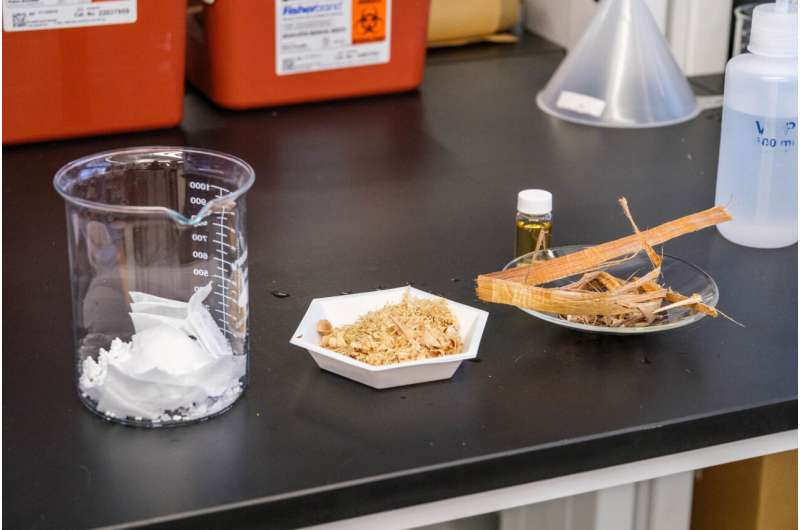This article has been reviewed according to Science X's editorial process and policies. Editors have highlighted the following attributes while ensuring the content's credibility:
fact-checked
peer-reviewed publication
trusted source
proofread
Microplastic pollution: New device uses wood dust to trap up to 99.9% of microplastics in water

Could plants be the answer to the looming threat of microplastic pollution? Scientists at UBC's BioProducts Institute found that if you add tannins—natural plant compounds that make your mouth pucker if you bite into an unripe fruit—to a layer of wood dust, you can create a filter that traps virtually all microplastic particles present in water.
While the experiment remains a lab set-up at this stage, the team is convinced that the solution can be scaled up easily and inexpensively once they find the right industry partner.
Microplastics are tiny pieces of plastic debris resulting from the breakdown of consumer products and industrial waste. Keeping them out of water supplies is a huge challenge, says Dr. Orlando Rojas, the institute's scientific director and the Canada Excellence Research Chair in Forest Bioproducts.
He noted one study which found that virtually all tap water is contaminated by microplastics, and other research which states that more than 10 billion tons of mismanaged plastic waste will be dispersed in the environment by 2025.
"Most solutions proposed so far are costly or difficult to scale up. We're proposing a solution that could potentially be scaled down for home use or scaled up for municipal treatment systems. Our filter, unlike plastic filters, does not contribute to further pollution as it uses renewable and biodegradable materials: tannic acids from plants, bark, wood and leaves, and wood sawdust—a forestry byproduct that is both widely available and renewable."
Captures a wide variety of plastics
For their study, the team analyzed microparticles released from popular tea bags made of polypropylene. They found that their method (they're calling it "bioCap") trapped from 95.2 percent to as much as 99.9 percent of plastic particles in a column of water, depending on plastic type. When tested in mouse models, the process was proved to prevent the accumulation of microplastics in the organs.
Dr. Rojas, a professor in the departments of wood science, chemical and biological engineering, and chemistry at UBC, adds that it's difficult to capture all the different kinds of microplastics in a solution, as they come in different sizes, shapes and electrical charges.
"There are microfibers from clothing, microbeads from cleansers and soaps, and foams and pellets from utensils, containers and packaging. By taking advantage of the different molecular interactions around tannic acids, our bioCap solution was able to remove virtually all of these different microplastic types."
Collaborating on sustainable solutions
The UBC method was developed in collaboration with Dr. Junling Guo, a professor at the Center of Biomass Materials and Nanointerfaces at Sichuan University in China. Marina Mehling, a Ph.D. student at UBC's department of chemical and biological engineering, and Dr. Tianyu Guo, a postdoctoral researcher at the BioProducts Institute, also contributed to the work.
"Microplastics pose a growing threat to aquatic ecosystems and human health, demanding innovative solutions. We're thrilled that the BioProducts Institute's multidisciplinary collaboration has brought us closer to a sustainable approach to combat the challenges posed by these plastic particles," said Dr. Rojas.
More information: Yu Wang et al, Flowthrough Capture of Microplastics through Polyphenol‐Mediated Interfacial Interactions on Wood Sawdust, Advanced Materials (2023). DOI: 10.1002/adma.202301531
Journal information: Advanced Materials
Provided by University of British Columbia





















